12.4 Understanding the Inventory Server Roles
This section describes the following roles that you can assign for an Inventory server:
For a quick reference table of the Inventory Server roles, see Section 12.4.10, Quick Reference Table of the Inventory Server Roles.
12.4.1 Root Server
The Root Server has the following characteristics:
-
This server is the topmost Inventory server in the inventory tree hierarchy.
-
This server has an Inventory database attached to it.
Choose Root Server to store the inventory information for your enterprise in a centralized database. The Inventory database at the Root Server contains the inventory information for all the lower-level Inventory servers.
Figure 12-1 depicts Leaf Servers connected to the Intermediate Server with Database. The Intermediate Server is attached to the Root Server.
Figure 12-1 Root Server
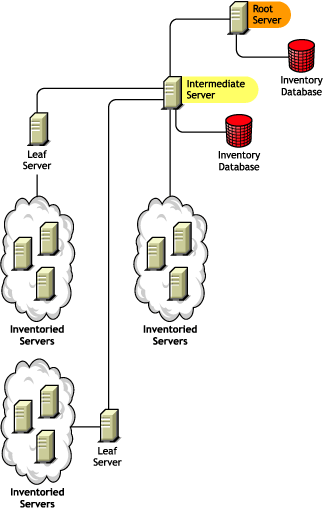

12.4.2 Root Server with Inventoried Servers
The Root Server with Inventoried Servers has the following characteristics:
-
This server is the topmost Inventory server in the inventory tree hierarchy.
-
This server has an Inventory database and inventoried servers attached to it. We recommend that you have to deploy these inventoried servers in a LAN.
Choose Root Server with Inventoried Servers if you want to store the inventory information of your enterprise in a centralized database and if you have inventoried servers in the same site as the Root Server. You can directly send the inventory information from these inventoried servers to the Root Server. The Inventory database at the Root Server with Inventoried Servers contains the inventory information for all these inventoried servers as well as for all the lower-level Inventory servers.
Figure 12-2 depicts a Root Server with inventoried servers and Inventory database attached to it. The Leaf Servers are connected to the Root Server.
Figure 12-2 Root Server with Inventoried Servers
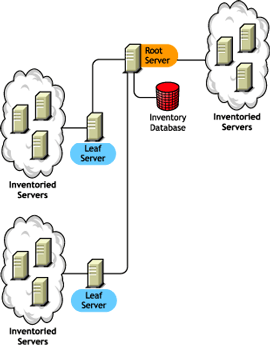

12.4.3 Intermediate Server
The Intermediate Server has the following characteristics:
-
This Inventory server acts as a staging server for the lower-level Leaf Servers.
-
This server moves the inventory information to the next-level Inventory server.
-
This server does not have inventoried servers or an Inventory database attached to it.
-
There can be one or more Intermediate Servers in your enterprise.
Place Intermediate Servers on sites where the link parameters change substantially. The Intermediate Server stores the scan files to the disk to make up for the difference in bandwidth and reliability.
Figure 12-3 depicts an Intermediate Server connected to a Root Server. Two Leaf Servers roll up the inventory information to the Intermediate Server. This Intermediate Server rolls up the inventory information to another Intermediate Server that is connected to the Root Server.
Figure 12-3 Intermediate Server
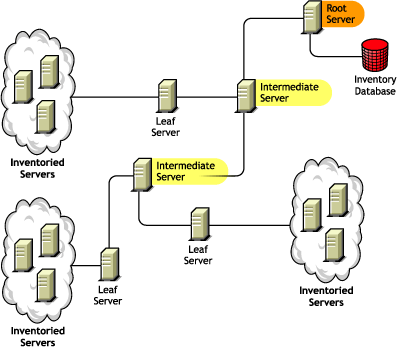

In this illustration, there are many Leaf Servers and Intermediate Servers at different levels. The Intermediate Server is a staging server for uploading the scan information to the next-level server. The last Intermediate Server is attached to the topmost Root Server. This scenario is typical if there are many Leaf Servers in different geographical locations. All the Leaf Servers move the inventory information to the Intermediate Server.
In some scenarios, the Leaf Server connects to the Intermediate Server over a WAN.
12.4.4 Intermediate Server with Database
The Intermediate Server with Database has the following characteristics:
-
This Inventory server acts as a staging server for the lower-level Leaf Servers.
-
This server moves the inventory information to the next-level Inventory server.
-
This server has an Inventory database attached to it.
-
There can be one or more Intermediate Servers with Database in your enterprise.
Choose Intermediate Server with Database if you want to administer an intermediate site by generating Inventory reports. The inventory information that is rolled up to this Inventory server is stored in the local Inventory database and also rolled up to the next-level Inventory server.
Figure 12-4 depicts two Leaf Servers attached to the Intermediate Server. A consolidated inventory information of all Leaf Servers is available at the Intermediate Server level.
Figure 12-4 Intermediate Server with Database
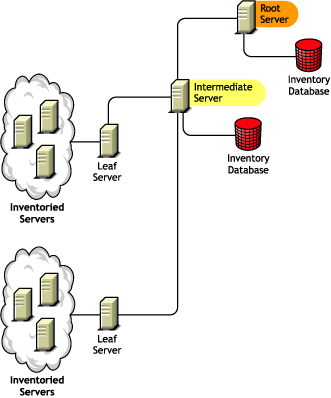

12.4.5 Intermediate Server with Inventoried Servers
The Intermediate Server with Inventoried Servers has the following characteristics:
-
This Inventory server acts as an intermediate server for the lower-level Leaf Servers.
-
This server moves the inventory information to the next-level Inventory server.
-
This server has inventoried servers attached to it.
-
This server does not have an Inventory database attached to it.
-
There can be one or more Intermediate Servers with Inventoried Servers in your enterprise.
Choose Intermediate Server with Inventoried Servers if you want an Intermediate Server and the site having the Intermediate Server has inventoried servers, whose inventory information you want to store it at the Root Server.
Figure 12-6 depicts two Leaf Servers attached to the Intermediate Server. This Intermediate Server also has inventoried servers attached to it.
Figure 12-5 Intermediate Server with Inventoried Servers
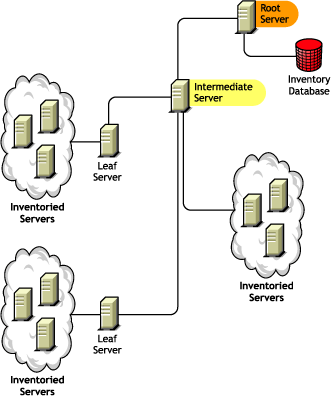

12.4.6 Intermediate Server with Database and Inventoried Servers
The Intermediate Server with Database and Inventoried Servers has the following characteristics:
-
This Inventory server acts as an staging server for the lower-level Leaf Servers.
-
This server moves the inventory information to the next-level Inventory server.
-
This server has inventoried servers attached to it.
-
This server has an Inventory database attached to it.
-
There can be one or more Intermediate Servers with Database and Inventoried Servers in your enterprise.
Choose Intermediate Server with Database and Inventoried Servers if you want the functionalities of Intermediate Server with Database and Intermediate Server with Inventoried Servers available on the site.
Figure 12-6 depicts two Leaf Servers attached to the Intermediate Server. The Intermediate Server has inventoried servers attached to it. A consolidated Inventory database of all Leaf Servers and the inventoried servers that are directly connected to the Intermediate Server is available at the Intermediate Server level.
Figure 12-6 Intermediate Server with Database and Inventoried Servers
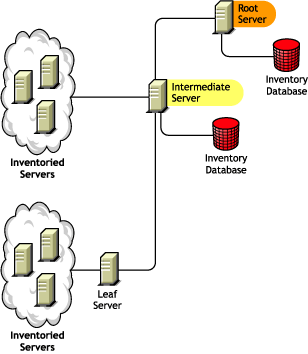

12.4.7 Leaf Server
The Leaf Server has the following characteristics:
-
This Inventory server is at the lowest level in the inventory tree hierarchy.
-
This server has inventoried servers attached to it.
-
This server moves the inventory information to the next-level Inventory server.
-
A simple Leaf Server does not have an Inventory database. An Inventory database is not required because there might be only few inventoried servers attached to the Leaf server.
Choose Leaf Server if you have inventoried servers at remote sites, and you want to obtain and store the inventory information from these inventoried servers in a centralized database.
Figure 12-7 depicts many Leaf Servers attached to the Intermediate Server. The Intermediate Server is connected to a Root Server. A consolidated Inventory database of all Leaf Servers is available at the Root Server level.
Figure 12-7 Leaf Server
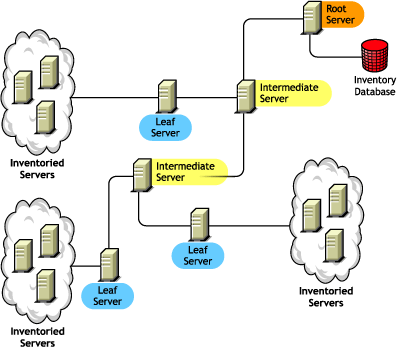

12.4.8 Leaf Server with Database
The Leaf Server with Database has the following characteristics:
-
This Inventory server is at the lowest level in the inventory tree hierarchy
-
This server has inventoried servers attached to it.
-
This server moves the inventory information to the next-level Inventory server.
-
This server has an Inventory database attached to it. You can assign a server as a Leaf Server with Database to maintain the inventory information for inventoried servers specific to the site.
Choose Leaf Server with Database if you want the functionalities of a Leaf Server as well as administer the site by generating Inventory reports
Figure 12-8 depicts two Leaf Servers attached to the Intermediate Server. One Leaf Server has an Inventory database attached to it. This database contains a consolidated inventory of all inventoried servers attached to this Leaf Server.
Figure 12-8 Leaf Server with Database
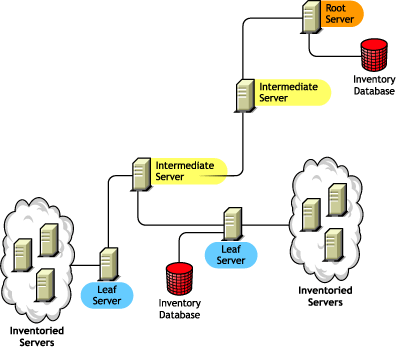

12.4.9 Standalone Server
The Standalone Server has the following characteristics:
-
This Inventory server has inventoried servers attached to it.
-
This server has an Inventory database attached to it.
-
There is no roll-up of scan information and there are no requirements for Intermediate Servers and a Root Server.
Use a Standalone Server if your network is made up of a single site and you want to administer that site.
Figure 12-9 depicts Standalone Server:
Figure 12-9 Standalone Server
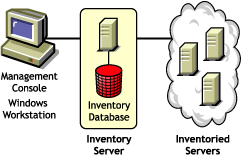

12.4.10 Quick Reference Table of the Inventory Server Roles
Table 12-1 Inventory Server Roles